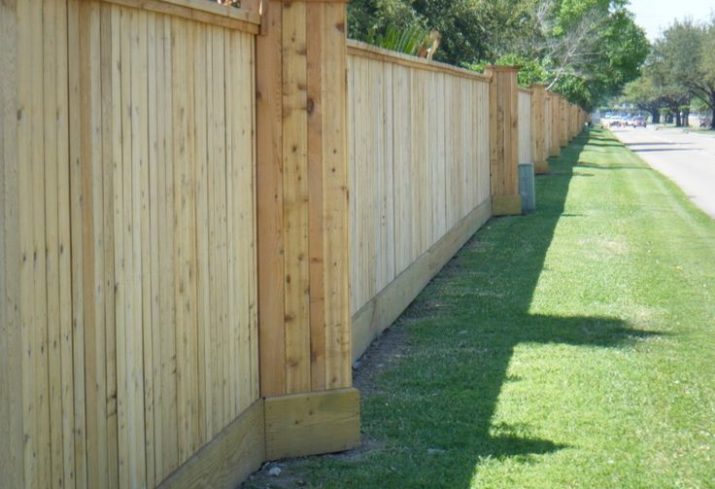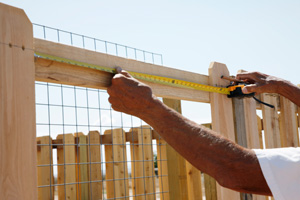Clues You Need Urgent Fence Repair Before Damage Gets Worse
Just How to Determine Common Concerns That Call For Immediate Fencing Repair Service
When it concerns keeping your fencing, it is essential to spot problems before they end up being bigger issues. On a regular basis checking for indicators of decomposing timber, leaning panels, or corrosion can conserve you money and time in the lengthy run. You might not understand exactly how weather and parasites can jeopardize your fencing's integrity. Let's explore the typical indicators that suggest your fencing requires instant interest, so you can maintain your residential property protected and looking its finest.
Indicators of Rotting Timber in Wooden Fences
Have you seen your wooden fence looking a bit shabby? It might be time to check for indicators of rotting timber if so. Initially, take a look at the base of the messages and panels for soft areas. If you press on the wood and it really feels squishy or crumbles, that's a clear indication of rot. Next, try to find discoloration or dark areas on the timber-- these frequently signal wetness damages. Pay interest to any kind of peeling paint or finish, as this can expose the wood to further degeneration. Additionally, a pungent, musty odor can suggest fungal development. Don't forget to evaluate links and joints; if they're loosened or falling apart, the timber beneath is likely jeopardized. By capturing these indications early, you can avoid much more extensive damage and maintain your fencing standing strong. Normal upkeep is vital to expanding the life of your wood fencing.
Leaning or Tilting Fencing Panels
It's essential to recognize what caused it if you have actually noticed your fence panels leaning or tilting. This concern might suggest underlying structural damages that needs your focus. Allow's explore the typical reasons and the repair service options available to get your fence back fit.

Root Causes Of Leaning Panels
It's commonly a sign of underlying concerns that need resolving when you see your fence panels leaning or tilting. One typical reason is poor drainage; extreme water can deteriorate the soil around the fencing posts, compromising their assistance. Another wrongdoer could be solid winds or storms that push against the panels, especially if they're not appropriately secured. In addition, the natural settling of dirt with time can create posts to change, leading to a tilt. Pests, like termites, can endanger the stability of wood panels, triggering them to lean too. Bad installation practices may result in panels not being firmly set, leaving them vulnerable to leaning under pressure. Address these issues immediately to maintain your fencing's stability.
Signs of Structural Damages
Seeing tilting or leaning fencing panels can be worrying, as these problems usually suggest architectural damage that requires immediate interest. When your fencing begins to lean, it might signify that the posts are shifting or that the dirt around them has actually eroded. Pay very close attention to gaps in between posts or panels, as these can also suggest instability. deck builder. In addition, check for fractures or splintering in the wood, which can damage the overall structure. If you notice rust or deterioration on steel components, it might endanger the integrity of the fence. Remember, overlooking these indications can result in much more serious damages down the line, so it's important to examine the scenario immediately and do something about it before it worsens
Repair Service Options Available

Rust and Rust in Steel Fences
If you own a steel fencing, you might discover corrosion and corrosion slipping in gradually, especially if it's subjected to dampness. These concerns not only influence the look of your fence but can additionally endanger its structural honesty. To identify corrosion, search for reddish-brown places or patches, which show the steel is oxidizing. Rust can spread out promptly if left neglected, damaging the fence and leading to pricey repairs.To deal with rust and rust, you must cleanse the impacted locations with a wire brush and apply a rust-inhibiting guide. Once the primer dries out, consider repainting the fence with a weather-resistant paint to secure it better. Normal upkeep, such as checking for indicators of rust and retouching paint as required, will certainly aid extend your fence's lifespan. Attending to these issues immediately guarantees your steel fence remains strong and aesthetically appealing for years to come.
Fractures and Splits in Vinyl Fence

Reasons of Vinyl Damages
Vinyl fencing is popular for its durability, yet it can still experience splits and divides as a result of numerous aspects. One major cause is severe temperature level changes. It can compromise the material over time when vinyl increases in the warmth and contracts in the cold. In addition, exposure to rough sunshine can result in UV destruction, making the plastic fragile. Physical influences, like unintentional crashes or hefty branches, can additionally create fractures. Poor installment or using low-quality products can exacerbate these concerns. Age plays a function; older plastic fencing is extra prone to damage. Routine assessments can assist you identify these elements before they bring about substantial troubles. Take proactive steps to ensure your fencing continues to be undamaged and solid.
Fixing Cracks Effectively
Although fractures and splits in your vinyl fence can be worrying, resolving them promptly continue reading this can protect against further damages and maintain the fence's appearance. Initially, assess the size of the crack. For little splits, a vinyl repair set typically includes glue that can bond the edges, offering a smooth solution. Clean the area extensively prior to applying the adhesive, ensuring it adheres appropriately. For larger divides, you may need to make use of a plastic spot. Cut the spot to dimension, use adhesive around the sides, and press it strongly onto additional resources the split. Allow it to treat based on the manufacturer's guidelines. Regular upkeep and quick repair work can prolong your fencing's life expectancy, keeping it looking terrific for years to find.
Loosened or Missing Fence Blog Posts
Absent or loosened fence blog posts can threaten the security of your entire fencing structure. If you discover any posts leaning or tottering, it's necessary to address the concern right away. Check for any signs of movement, as this can result in further damages in time. You can quickly assess the problem by providing each post a gentle shake-- if it feels unpredictable, it's time to take action.For missing blog posts, you'll need to replace them immediately to maintain your fence's stability. Make sure they're securely anchored in the ground with concrete or crushed rock for included security when you install new posts. If a blog post hangs, tighten it by adding extra support or driving it deeper into the ground.Ignoring these issues can lead to bigger problems, like spaces in your fence or also full collapse. So, maintain an eye on your messages and stay proactive regarding repairs!
Damages From Climate and Natural Environment
Climate and natural environments can damage your fencing, causing different kinds of damages that call for timely interest. Heavy rain can create wood to rot, making it weak and unpredictable. Snow accumulation may bend or break panels, while strong winds can root out fencing blog posts or trigger sections to lean.If you notice cracks article source or splintering in wooden fences, it's a sign of drying out as a result of intense sunlight exposure. On the other hand, steel fencings can corrosion if protective layers diminish, specifically in humid or seaside areas.Inspect your fencing on a regular basis after tornados or severe climate to capture any damages early. Attending to these issues rapidly can conserve you from expensive repair services down the line. Do not wait until a small trouble becomes a major one; stay proactive and keep your fencing in top form to keep both performance and aesthetic charm.
Insect Invasion and Termite Damage
It's crucial to act promptly to avoid more devastation when you observe indicators of insect infestation or termite damage. Look for mud tubes along your fencing or hollow-sounding wood, as these suggest termites are at job. You might additionally see tiny holes or frass, which is termite droppings looking like sawdust. If you spot any one of these indications, it's time to evaluate the damage.Don' t delay up until it's far too late; parasites can endanger your fence's integrity. Check the surrounding area for ants or beetles, as they may be adding to the issue. If you believe an invasion, think about contacting a bug control expert to verify and deal with the issue.Repairing or replacing afflicted areas of your fence promptly not just restores its stamina but also prevents parasites from spreading out additionally. Remain attentive to keep your building safe and secure and pest-free.
Often Asked Concerns
How Often Should I Evaluate My Fencing for Damage?
You ought to evaluate your fence at the very least two times a year, ideally throughout spring and fall. Regular checks assist you spot damages early, conserving you time and cash on fixings while keeping your residential property's appearance and safety and security.
Can I Repair a Fencing Myself or Hire an Expert?
If you have the right devices and skills, you can definitely fix a fence yourself. Nonetheless, working with an expert guarantees top quality job and saves you time, especially for complicated repairs or comprehensive damages.
What Devices Are Needed for Standard Fence Repair Services?
For standard fencing fixings, you'll need tools like a hammer, screwdriver, pliers, a saw, a level, and measuring tape. deck builder. Relying on the repair, you may likewise call for nails, screws, or replacement boards
Exactly How Much Does Fencing Fixing Usually Expense?
Fencing repair service prices differ extensively, but you can expect to pay between $200 and $1,500 depending on materials, labor, and level of damage. It's clever to get numerous quotes for the very best deal.
When Is the Ideal Season for Fence Repair Works?
The very best time for fencing fixings is throughout mild weather condition, usually in spring or very early autumn. You'll avoid severe temperature levels, making it easier to function and ensuring the materials set effectively for lasting toughness (deck builder). Seeing leaning or turning fencing panels can be worrying, as these problems frequently suggest architectural damage that needs prompt interest. Missing or loose fencing articles can undermine the security of your entire fencing framework. Snow build-up may flex or break panels, while strong winds can uproot fence articles or cause areas to lean.If you notice splits or splintering in wooden fencings, it's a sign of drying out due to extreme sun exposure. Metal fences can rust if protective finishings use off, specifically in seaside or humid areas.Inspect your fencing consistently after storms or severe weather to capture any damages early. Fence repair service costs differ commonly, yet you can expect to pay between $200 and $1,500 depending on products, labor, and level of damage